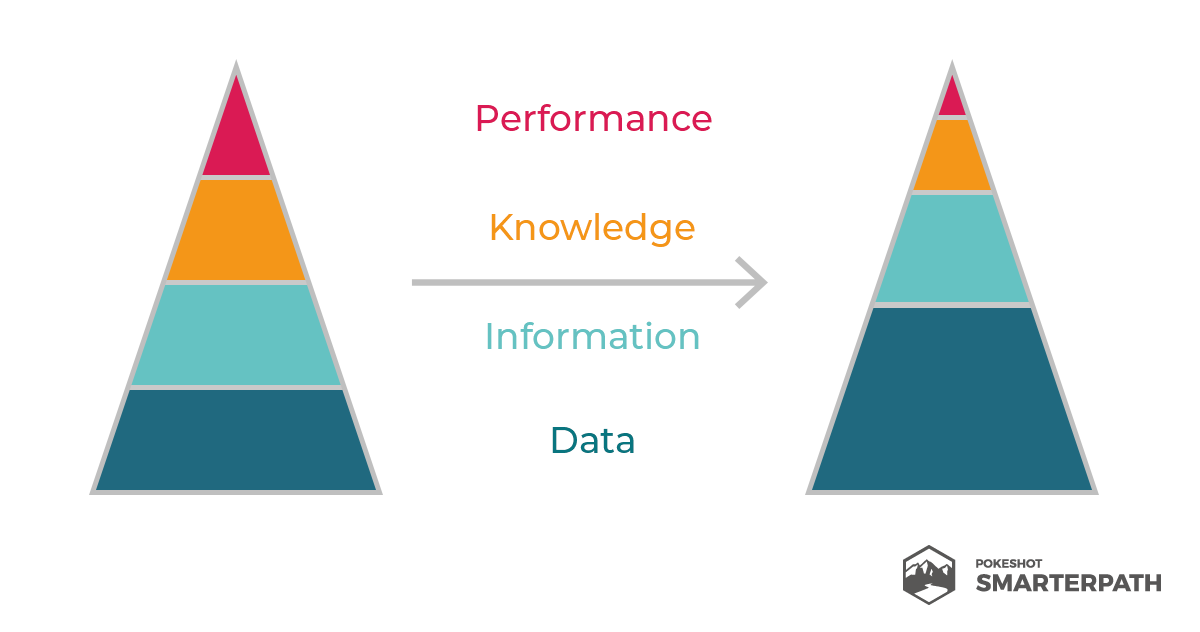Lately, I’ve been working intensively on the topic of knowledge management. Along with posts on content “upcycling” and “making knowledge visible”, this post is the third in this series.
What is it all about?
If we think about knowledge management, or “knowledge” in general, it is not something we “have.” After all, we can’t possess knowledge, so it’s hard for us to “manage” it. This is something we should remember. Instead, we are in a constant process of acquiring and disposing knowledge: if we don’t use or apply something, we tend to forget it – everyone is familiar with this. So how can we repeatedly turn new information into knowledge that can then be used directly?
Let’s tackle things one at a time. If you look at common models, e.g. the DIKW pyramid or the knowledge staircase proposed by Klaus North, it quickly becomes clear that it is not enough to merely impart new knowledge to employees. It is interesting to note that these models were already developed at the end of the 1980s and early 2000s, yet topics such as performance and 70:20:10 are only slowly beginning to find their way into companies now.
Information overload, the outcome and the underlying problem
One model I’ve given thought to in this context is the DIKW pyramid. DIKW stands for “data, information, knowledge and wisdom,” and in models from the 1980s, the difference between the data flowing in at the bottom and the outcome (wisdom, performance) is not significant. This made me reflect on things, because there seems to have been a massive shift in recent years. A huge gap has opened up between the amount of data that we are subjected to daily and the amount of knowledge we hold onto. Don’t you feel the same way? How much of the information you absorbed this morning could you now reproduce ad hoc?
Our daily business life has completely changed (enterprise social networks, instant communication, etc.), leading to a significant increase in the amount of data and information we are exposed to. Employees are bombarded with this flood, making it increasingly difficult to extract the necessary knowledge, let alone improve performance. Jumping to the conclusion that people should no longer share their knowledge in social networks would be premature at this point. Rather, the conclusion should be a rethinking toward more targeted content processing for all employees.

The DIKW pyramid in the 2000s and today
In my opinion, there are two connecting factors:
- Reducing the amount of data and information that affects employees
- Reinforcing the knowledge and performance base
What does this mean exactly?
Businesses have to succeed in “transforming” the knowledge pyramid into a more targeted knowledge rectangle. The amount of data and information that is “thrown in” at the bottom should, at best, come out on top as wisdom among employees. To ensure this, not all data and information has to necessarily arrive with employees; what’s more, the knowledge that employees receive must lead more quickly to performance.

Shift toward a knowledge rectangle
A company can access a number of tools that can be assigned to the individual corners of the new rectangle. Here are a few of them.
Reducing the amount of data and information:
- Stemming the flood of information/building knowledge: knowledge upcycling:As described in my blog post on this topic, companies should enable their employees to reuse and/or restructure content, as necessary.
- Stemming the flood of information/building knowledge: the domain expert as filter: Specialist departments frequently know best which contents may be relevant for a department or colleagues. In line with the “Learner as Creator” principle, companies should offer their staff the chance to provide knowledge as intelligent pathways. And not only for content within a platform, but also outside of it.
- Building knowledge: artificial intelligence: It may sound pompous, but A.I. starts with simple things. Based on various parameters, a system should be able to show me contents I am interested in, without my having to look for them explicitly. In the best of all cases, of course, this happens fully automatically.
- Promoting employee performance: 70:20:10: Nowadays, it’s no longer enough to simply send employees out on training courses. This should be clear to many companies – at the latest with the emergence of 70:20:10 models. Staff performance needs to be boosted, preferably by employees acquiring their own experiences. Modern tools like SmarterPath, Epilogue and UserLane support this.
Is this how you see it, too? I’d be happy to have an exchange of ideas on these topics with you. Feel free to write me a message by email, LinkedIn or Twitter. I’m looking forward to reading your comments!
 About the author:
About the author:
Sandra Brückner, who studied business informatics at the Technical University of Dresden, has worked as social business consultant since 2012. She joined the Berlin-based social business consultancy and technology provider Pokeshot in the beginning of 2014 and has served for more than two years as Chief Product Officer for all products.
Connect with us on facebook | twitter | LinkedIn | YouTube – we will keep you posted!